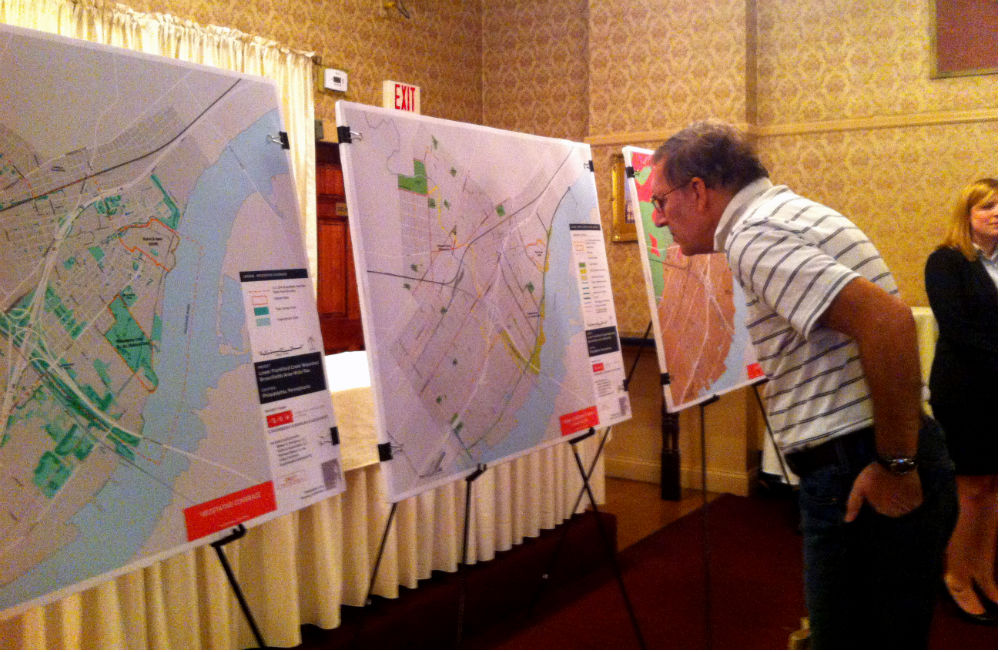Bridesburg residents weigh in on brownfields planning

Bridesburg residents gathered at a catering hall Tuesday night to weigh in on the Lower Frankford Creek Watershed Brownfields Area-Wide Plan. The city was awarded a grant from the Environmental Protection Agency last year to complete a study aimed at spurring cleanup and development of brownfield lands in area covering parts of Bridesburg, Frankford, Port Richmond and Juniata Park.
Sean Garrigan, a principal at the landscape architecture and urban planning firm Stromberg/Garrigan, explained that brownfields are areas that have or are perceived to have environmental constraints that prevent them from being developed into new uses. The sites may or may not have serious pollution problems, but Garrigan said the group will not be doing any “environmental investigative work” to test the land for pollution or hazardous materials. That work is outside the scope of their research, which only employs information that’s already in the public domain.
The brownfields planning process is meant to complement the district planning that is slated to get underway in the River Wards soon, and Tuesday night’s meeting was structured much the same way as the Philadelphia2035 community engagement events. Attendees were given maps of the area in question and asked to identify the community’s assets and needs.
They were also asked to envision specific uses for the three currently vacant sites that the brownfields planning is based on: the former Philadelphia Coke Co. property, a property owned by Dow Chemical (Rohm and Haas), and the Edgewater Dyeing and Finishing site in Frankford. The first two sites are Delaware River waterfront properties in Bridesburg; Edgewater Dyeing is at the corner of Frankford and Torresdale avenues.
Garrigan said the planning is primarily about those three “catalyst sites.” The group working on the plan, Garrigan’s firm and members of the Planning Commission, is performing a market analysis of the area and will end up recommending certain types of land uses for the key sites. Garrigan stressed that the brownfields planning process won’t end with zoning recommendations; those will be produced through the Philadelphia2035 process.
“We can just show from a broad market sense what the opportunities may be,” Garrigan said.
The final recommendations will be based on market analysis and input from the community.
On Tuesday night, residents identified a broad range of public goods as their neighborhood’s assets: the elementary school, the park, the recreation center, some churches, and access to Interstate 95. (Bridesburg is one of the only neighborhoods on the waterfront side of the interstate, and yet it’s still cut off from the river by mostly industrial land. Though that will change soon.)
In terms of what they’d like to see built in the community, the suggestions were more aspirational. A dog park, said one woman. A waterfront restaurant with boat slips. A new community center. A casino, said someone else, sarcastically.
John Haak, a Planning Commission staff member who’s heading up the brownfields planning, said at this stage in the planning process—the group will hold two more public meetings—it’s good to get a wide range of views, and that the group can narrow down what’s feasible as the process moves forward.
What’s the best outcome of a meeting like this?
“Getting really well-grounded community feedback and knowledge … about people’s hopes and concerns for future development,” Haak said.
The planning group will gather the residents’ suggestions and begin posting plan information on its website in the next few weeks. The next community meeting will likely take place early next year.
WHYY is your source for fact-based, in-depth journalism and information. As a nonprofit organization, we rely on financial support from readers like you. Please give today.



